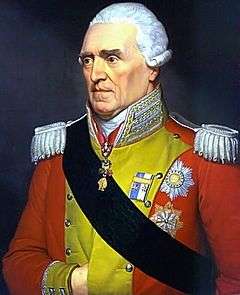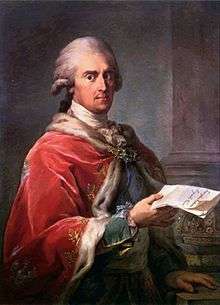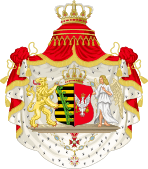Frederick Augustus I of Saxony
| Frederick Augustus I | |||||
|---|---|---|---|---|---|
 | |||||
| King of Saxony | |||||
| Reign | 20 December 1806 – 5 May 1827 | ||||
| Coronation | 20 December 1806 | ||||
| Successor | Anthony | ||||
| Regent | Maria Antonia of Bavaria | ||||
| Duke of Warsaw | |||||
| Reign | 9 June 1807 – 22 May 1815 | ||||
| Elector of Saxony | |||||
| Reign | 17 December 1763 – 20 December 1806 | ||||
| Predecessor | Frederick Christian | ||||
| Born |
23 December 1750 Dresden | ||||
| Died |
5 May 1827 (aged 76) Dresden | ||||
| Burial | Katholische Hofkirche | ||||
| Spouse | Amalie of Zweibrücken-Birkenfeld | ||||
| Issue | Princess Maria Augusta of Saxony | ||||
| |||||
| House | House of Wettin | ||||
| Father | Frederick Christian, Elector of Saxony | ||||
| Mother | Princess Maria Antonia of Bavaria | ||||
| Religion | Roman Catholicism | ||||
| Signature |
| ||||
Frederick Augustus I (full name: Frederick Augustus Joseph Maria Anthony John Nepomuk Aloysius Xavier; German: Friedrich August Josef Maria Anton Johann Nepomuk Alois Xavier; Polish: Fryderyk August Józef Maria Antoni Jan Nepomucen Alojzy Ksawery Wettyn; 23 December 1750 – 5 May 1827) was King of Saxony (1805–1827) from the House of Wettin. He was also Elector Frederick Augustus III (Friedrich August III.) of Saxony (1763–1806) and Duke Frederick Augustus I (Polish: Fryderyk August I) of Warsaw (1807–1813).
Succeeding his father in 1763 as the elector Frederick Augustus III, he brought order and efficiency to his country's finances and administration. In foreign policy, he was neutralist but drifted towards Prussia, whose side he took in the Bavarian succession dispute (1778–79), when it prevented Bavaria's cession to Austria.[1] For his cooperation he received substantial financial compensation from Prussia. In 1785, Frederick Augustus joined the Prussian-sponsored Fürstenbund (League of Princes), but remained neutral during the Austro-Prussian dispute in 1790. Offered the Polish crown in 1791, he declined as he feared that his "risky" politics may cause further damage to the Polish state, which was already weak and eventually stopped existing in 1795. The next year Saxony reluctantly joined the coalition against Revolutionary France but was defeated by 1796. Again entering the struggle on Prussia's side in 1806, after the decisive defeat at Jena in the same year, Frederick Augustus made peace with Napoleon, which secured the title of king of Saxony for him. A year later, Napoleon secured the Grand Duchy of Warsaw for him. Frederick Augustus remained a loyal ally to France even after the disastrous Russian campaign (1812–13). Although he had started half-hearted negotiations with Austria, he broke them off after the French victory at Lützen (May 1813). In the Battle of Leipzig (October 1813), however, his troops went over to Prussia and he was taken prisoner. At the Congress of Vienna in 1815, Frederick Augustus lost three-fifths of his territory to Prussia. He spent the rest of his life attempting to rehabilitate his truncated state.[1]
Throughout his political career Frederick Augustus tried to rehabilitate and recreate the Polish state that was torn apart and stopped existing after the final partition of Poland in 1795, however he did not succeed - for this he would blame himself for the rest of his life.
The Augustusplatz in Leipzig is named after him.
Elector of Saxony and Designated King of Poland
Family Background
He was the second (but eldest surviving) son of Frederick Christian, Elector of Saxony, and Maria Antonia Walpurgis of Bavaria, Princess of Bavaria. Because he was underage at the time of the death of his father in 1763, his mother served as Regent until 1768. His uncle Prince Franz Xavier functioned as his representative.[2]
Renunciation of the Polish throne
In 1765 Prince Franz Xavier ceded the Polish throne to Stanisław II Augustus on behalf of the underage Elector. Frederick Augustus was named successor to Stanislaw, however, when a Polish Constitution was ratified by the lower House (Sejm) of the Polish Parliament. At the same time, the head of the Saxon Royal House was established as heir to the Polish throne (Article VII of the Polish Constitution). Frederick Augustus declined to accept the crown upon Stanislaw's death in 1798, because he feared becoming entangled in disputes with Austria, Prussia and Russia, who had begun to partition Poland in 1772.[3] As a matter of fact, a full partition of Poland among the neighboring powers of Austria, Prussia, and Russia had already taken place by 1795.
Foreign policy up to the dissolution of the Holy Roman Empire

In August 1791, Frederick Augustus arranged a meeting with Holy Roman Emperor Leopold II and King Friedrich Wilhelm II of Prussia at Pillnitz Castle that was intended partly to offer support for the French monarchy in the face of revolutionary agitation in France.[2] The Declaration of Pillnitz warned of the possibility of military action against the French revolutionary government, a provocation that provided it with grounds to declare war on Austria in April 1792. Frederick Augustus himself did not sign the Declaration.
Saxony wanted nothing to do with the defensive alliance against France formed between Austria and Prussia. Nonetheless, a proclamation of the Reichstag of the Holy Roman Empire issued in March 1793 obligated Frederick Augustus to take part. There was great concern in Saxony in April 1795 when Prussia suddenly concluded a separate peace with France in order to facilitate the partition of Poland. Saxony dropped out of the coalition against France in August 1796 after France had advanced east into the German lands and additional conditions for the Holy Roman Empire to conclude a separate peace were agreed to.
Both the peace agreement with France and Saxony's participation in the Congress of Rastatt in 1797 served to demonstrate Frederick Augustus' loyalty to the conventional constitutional principles of the Holy Roman Empire. The Congress of Rastatt was supposed to authorize the surrender of left bank areas of the Rhine to France in return for compensation for the rulers who were relinquishing their territories. Saxony refused to agree to territorial adjustments that were designed to benefit Bavaria, Prussia, Württemberg, and Baden at the Congress of Rastatt and in 1803 at the issuance of the Final Report of the Empire Delegation [the law of the Holy Roman Empire that laid out the new order of the Empire].
Foreign policy until the peace with Napoleon
Frederick Augustus also did not participate in the creation of the Confederation of the Rhine, which led to the final dissolution of the Holy Roman Empire. With respect to the Prussian idea of a north German empire, within which Saxony was supposed to be raised to a kingdom, he appeared reserved. However, when Napoleon advanced as far as Thuringia after September 1806 in response to the Berlin Ultimatum, which demanded the withdrawal of French troops from the left bank of the Rhine, Frederick Augustus joined with Prussia. At the twin battles of Jena and Auerstedt in 1806 the Prussian – Saxon troops suffered a crushing defeat at the hands of Napoleon. Separated from Prussia, whose state and army leadership withdrew headlong to the east, left without any information concerning Prussian intentions, and with Napoleon's troops about to occupy Saxony, Frederick Augustus had to conclude peace. On 11 December 1806 in Poznań a treaty was signed by authorized representatives of both sides. Saxony was forced to join the Confederation of the Rhine and had to surrender areas of Thuringia to the recently organized Kingdom of Westphalia. As compensation, Saxony was given the area around Cottbus and was raised to the status of a kingdom alongside the Confederation states of Bavaria and Württemberg.
King of Saxony and Duke of Warsaw
Elevation to Saxon-Polish ruler
Frederick Augustus was proclaimed king of Saxony on 20 December 1806. After the Treaty of Tilsit, which Frederick William III of Prussia and Czar Alexander I of Russia concluded with Napoleon in July 1807, Frederick Augustus was also named duke of Warsaw. Although he had rejected the offer of the kingdom of Poland in 1795 by the lower House of the Polish Parliament, he could not refuse a Polish title a second time.[2][3]
The Constitution of the Duchy of Warsaw, which Napoleon dictated to Saxony, joined the Duchy of Warsaw hereditarily to the Royal House of Saxony in Article V, which was linked to the Polish Constitution of 1791. Geopolitically the Duchy of Warsaw comprised the areas of the 2nd and 3rd Prussian partitions (1795), with the exception of Danzig (Gdańsk), which was made into the Free City of Danzig under joint French and Saxon "protection", and the district around Białystok, which was given to Russia. The area of Prussian control was made up of territory from the former Prussian provinces of New East Prussia, Southern Prussia, New Silesia, and West Prussia. In addition, the new state was given the area along the Noteć river and the "Land of Chełmno".
Altogether, the Duchy had an initial area of around 104,000 km², with a population of approximately 2,600,000. The bulk of its inhabitants were Poles.
In 1809, Austria was successfully defeated by Polish–Saxon troops after it attempted to take possession of the Duchy and for its part had to cede to the Duchy of Warsaw Polish regions absorbed up to 1795, among them the old Polish royal city of Kraków. In July 1812 Frederick Augustus ratified a proclamation of the Polish Parliament that restored the Kingdom of Poland. Napoleon lodged a protest against this action.
Events during the War of Liberation

In 1813 during the War of Liberation, Saxony found itself in a more difficult situation than many other warring states. The country was still solidly in Napoleon's grip and at the same time had become the central arena of the war. In the autumn of 1813 at the start of the Battle of Leipzig (Battle of Nations) the local population of Saxony, which tallied about 2 million, saw almost a million soldiers brought to its territories. Napoleon openly threatened to consider Saxony as enemy territory and treat it accordingly should Frederick Augustus change sides. Frederick Augustus' room for maneuver was consequently greatly limited. He did not want to put the country's well-being into play frivolously. At the same time, he still remembered vividly the way in which Prussia had simply abandoned him in 1806.
In this difficult situation the King attempted to enter cautiously into an alliance with the Sixth Coalition in 1813 without risking a public break with Napoleon and a declaration of war. As the Prussian and Russian troops entered Saxony in the spring, the King first moved to the south in order to avoid a direct encounter and pursued an alliance with Austria secretly from Regensburg. The Saxon-Austrian Pact was concluded on 20 April and the King made the Prussian and Russian allies aware of it at the same time. Napoleon, from whom Frederick Augustus was not able to keep the diplomatic maneuvers concealed, summoned the King urgently to Saxony after he had defeated the Prussian-Russian troops at Lützen on 2 May. Frederick Augustus decided to comply with the ultimatum presented to him. With no prospect of concrete assistance from Austria, and in view of the defeat of the Prussian – Russian coalition, which now sent peace signals to France, he felt he had no choice.
Frederick Augustus' decision brought the country scarcely any relief. Napoleon, angered at the near defection of the King and at the same time dependent upon the full mobilization of all available forces against the Coalition troops, harshly demanded the full resources of Saxony. In addition, the country suffered under the changing fortunes of war and associated movements and quartering. At the end of August the Allies failed again to defeat Napoleon at the Battle of Dresden. Meanwhile, Saxony became the principal arena of war and Dresden the midpoint of the French army movements. Not until 9 September in Teplice (in the present-day Czech Republic) did Austria conclude its alliance with Prussia and Russia. As Napoleon's troops in Saxony formed up for the retreat before the expanded coalition, the first defectors from the Saxon army to the allies came in September.
Frederick Augustus was mistrustful of Prussia in view of the experiences of the spring and arguably disappointed as well by Austria's decision not to join the Coalition immediately, especially while the country was exposed as before to French domination. Thus he chose not to break with Napoleon. At the Battle of Leipzig [Battle of Nations] the Saxon as well as the Polish troops fought on the side of Napoleon. In view of the apparent defeat of the French, even larger Saxon troop formations went over to the Coalition during the battle, whereas the Polish troops were largely annihilated.
Settlement of Saxon affairs at the Congress of Vienna
At the deliberations of the Congress of Vienna in 1814 and 1815, Frederick Augustus' position was doomed by his country's difficult geographic position, the changing fortunes of war, a lack of assistance from Austria, and his own hesitant attitude. The Prussian-Russian alliance had never had an honorable intention in bringing Saxony into the anti-Napoleon alliance in the first place. Even before Prussia declared war on France on 17 March 1813, it had agreed to an alliance with Russia to the detriment of Saxony and Poland at Kalisz on 22 February: the Duchy of Poland would predominantly come under Russian rule, whereas Prussia would be compensated for relinquished Polish territories with the annexation of Saxon territory. Prussia's appetite for the economically and culturally more developed territories of Saxony originated in the old dream of annexation that Frederick II had developed in his political testament of 1752 and had already tried to realize in the Seven Years' War. It did not originate from any necessity to overcome Napoleonic rule in central Europe.
After the Battle of Leipzig the Prussian-Russian alliance showed no interest in an alliance with the Saxon king in the wider struggle against Napoleon irrespective of offers of support from Frederick Augustus. Rather, the King was taken into captivity to Friedrichsfelde near Berlin and placed under Russian-Prussian custody in the name of a "General Government of High Allied Powers."
The forceful manner of Prussian minister Baron von Stein, not the government administered by Russian Prince Repnin until November 1814 or the subsequent Prussian occupying force that lasted to June 1815, were responsible for the low morale in Saxony at the end of the Napoleonic Wars. In contrast to the representatives of France, Frederick Augustus was denied participation at the Congress of Vienna as punishment for his supposed role as the quasi- deputy of his former ally Napoleon. Certainly nothing other than the intention of Prussia and Russia to carry out the annexation plans agreed to in Kalisz was responsible for this treatment of the Saxon king. That Saxony was not completely abandoned can be attributed to the fear of Austria and France of an overly-strengthened Prussia. Because the Saxon question threatened to break up the Congress, the allies finally agreed to divide Saxony (7 January 1815) with the mediation of the Czar.
Acceptance of the post-war order of the Congress of Vienna
Frederick Augustus delayed his agreement to the division of his country after he was released from a Prussian prison in February 1815. Since the King had no choice, he finally gave in, and on 18 May consented to the peace treaty laid before him by Prussia and Russia. With the signing of the treaty on 21 May 1815, 57% of Saxon territory and 42% of the Saxon population was turned over to Prussia.
Places and areas that had been connected to the Saxon landscape for hundreds of years became completely foreign, absorbed in part into artificially created administrative regions. Examples include Wittenberg, the old capital of the Saxon Elector State during the Holy Roman Empire, and seat of the National University made famous by Martin Luther and Melanchthon (which was already done away with in 1817 by means of a merger with the Prussian University of Halle), and Torgau, birthplace and place of residence of the Elector Frederick the Wise, which was incorporated into one of the new hybrids created by Prussia under the name Province of Saxony. Lower Lusatia, which like Upper Lusatia had preserved its constitutional autonomy under Saxon rule, was incorporated into the Province of Brandenburg and ceased to exist as a state. Upper Lusatia was arbitrarily divided: the area assigned to Prussia, including Görlitz, was added to the Province of Silesia; these areas also lost their constitutional autonomy.
On 22 May 1815 Frederick Augustus abdicated as ruler of the Duchy of Warsaw, whose territory was annexed mainly to Russia, but also partly to Prussia and Austria. In the area assigned to Russia, a Kingdom of Poland was created to join in a hereditary union with the Czars. The old royal city of Kraków no longer belonged to the new kingdom, and became a separate republic. The internal autonomy that it enjoyed at first was abolished in 1831 after the Polish Uprising.
King of Saxony
Standing among the Saxon people upon his return
When Frederick returned home to Saxony in July 1815 he was greeted enthusiastically throughout the land. Numerous expressions of loyalty also reached the king from the ceded territories, where the populace regarded the new rulers coolly; shortly thereafter the notion of being "mandatory-Prussian" began to circulate. In Liège, where the majority of the regiments of the Saxon Army had been stationed since the beginning of 1815, there was a revolt at the end of April. At the behest of the Prussian king, Blücher was to discharge the soldiers who came from the annexed territories, but Frederick Augustus' men had not yet made their departure, and the Saxon soldiers rioted over it. Blücher had to flee the city and was able to put down the revolt only by calling up additional Prussian troops.
Public opinion in Saxony lay decisively on Frederick Augustus' side at the time of his return. There was a feeling that Prussian policies were too ruthless both against the country and the king. The avarice of special interests in Berlin came across all too clearly as the rewards of the War of Liberation were distributed.
Final years
The last twelve years of Frederick Augustus' government passed largely quietly.[2] The conservative character of the king, which in foreign policy up to 1806 had manifested itself in unconditional loyalty to Saxon interests, hardened even more after the experience of Napoleonic hegemony. With respect to political reform the King achieved little. Until his death in 1827, which falls on the same date as Napoleon's death anniversary, little was altered in the constitutional regulation of the Saxon state. To be sure, the king failed to do so out of respect for the rights of the remaining Lusatian upper classes. Just as little came of the desire of many people to transform the existing political system to accommodate a genuine parliament. There was scarcely any lessening of admiration for the old king who had overseen the destiny of Saxony for more than half a century. During his lifetime he gained the name "The Just". Resentment over the delayed economic and social rebuilding of the country was to be felt by his brother, King Anton.
Frederick Augustus was entombed in the Roman Catholic Cathedral of Dresden.[3]
Marriage and issue
In Mannheim on 17 January 1769 (by proxy) and again in Dresden on 29 January 1769 (in person), Frederick Augustus married the Countess Palatine (Pfalzgräfin) Amalie of Zweibrücken-Birkenfeld, sister of King Maximilian I Joseph of Bavaria. During their marriage, Amalia gave birth to four children, but only one daughter survived to adulthood:
- Stillborn child (1771)
- Stillborn child (1775)
- Maria Augusta Nepomucena Antonia Franziska Xaveria Aloysia (b. Dresden, 21 June 1782 – d. Dresden, 14 March 1863)
- Stillborn child (1797)
He had an illegitimate daughter, which was born out of a relationship of Friedrich August with the daughter of court Jew working in Dresden. [4]
Without surviving male issue, Frederick Augustus was succeeded as King of Saxony by his younger brother Anton.
Titles and styles
- 23 December 1750 – 5 October 1763: His Serene Highness Prince Friedrich August of Saxony
- 5 October 1763 – 17 December 1763: His Serene Highness The Electoral Prince of Saxony
- 17 December 1763 – 20 December 1806: His Serene Highness The Elector of Saxony
- 20 December 1806 – 5 May 1827: His Majesty The King of Saxony
Ancestors
See also
- History of Saxony
- Rulers of Saxony
- Dresden Castle – Residence of Frederick Augustus I
Notes and references
- 1 2 http://www.britannica.com/EBchecked/topic/217999/Frederick-Augustus-I
- 1 2 3 4 Heinrich Theodor Flathe: Friedrich August I., König von Sachsen. In: Allgemeine Deutsche Biographie (ADB). Volume 7, Duncker & Humblot, Leipzig 1878, pp. 786–789 (German)
- 1 2 3 Dagmar Schäfer: Der gefangene Sachsenkönig. Eine Erinnerung an Sachsens ersten König, Friedrich August I. (1750–1827). Tauchaer Verlag, Taucha 1996, ISBN 3-910074-52-9 (German)
- ↑ http://www.weber-gesamtausgabe.de/de/A000537/Korrespondenz
External links
![]() Media related to Frederick Augustus I of Saxony at Wikimedia Commons
Media related to Frederick Augustus I of Saxony at Wikimedia Commons
| Preceded by Frederick Christian |
Elector of Saxony as Frederick Augustus III 1763–1806 |
Succeeded by Electorate abolished |
| Preceded by Kingdom created |
King of Saxony 1806–1827 |
Succeeded by Anton |
| Preceded by Duchy created |
Duke of Warsaw 1807–1815 |
Succeeded by Duchy abolished |

